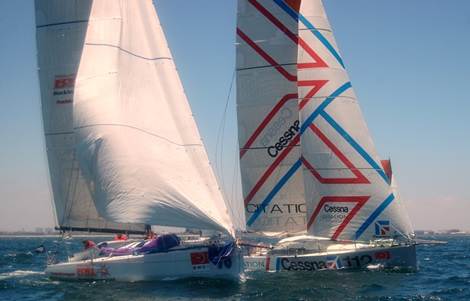Global Ocean Race resumes
At 12:00 GMT (14:00 local), the six, double-handed Class40s in the Global Ocean Race 2011-12 crossed the start line of Leg 2 from Cape Town to Wellington, New Zealand. Ahead of the fleet are approximately 7,000 miles and around one month of racing through the high latitudes of the Indian Ocean with a finish line ETA shortly after Christmas.
At 09:30 local time, the V&A Harbourmaster, Steven Bentley, stood-in as the GOR fleet’s chaplain, reading from Luke Chapter 8 – a verse advising sailors on a sinking ship that faith in yourself is valuable throughout life - before the boats left North Wharf and motored through Alfred Basin and Victoria Basin, exiting the V&A Waterfront Marina for a rendezvous at the committee boat off the city’s breakwater.
With a band of 20 knot breeze in the northern end of Table Bay, the 86ft GOR Committee Boat Pradera Blue anchored and the pin end of the line was set for a reaching start. Running the start line on behalf of Royal Cape Yacht Club, Di Hutton-Squire – mother of Phesheya-Racing co-skipper, Phillippa Hutton-Squire – fired the start gun at noon (10:00 GMT) with Conrad Colman and Sam Goodchild on Akilaria RC2 Cessna Citation first across, overtaken quickly by Leg 1 winners, New Zealand father-and-son duo of Ross and Campbell Field crossing the line on port reach close to the bow of the Committee Boat with their Tyker 40, BSL.
Heading immediately offshore, BSL and Cessna Citation – just metres apart – sailed to leeward of the enormous ocean-going tug, Fairmount Glacier, anchored in the middle of the course with Halvard Mabire and Miranda Merron on Pogo 40S² Campagne de France sailing to windward of the obstruction, followed by the Italian-Spanish duo of Marco Nannini and Hugo Ramon on their Akilaria Financial Crisis, squeezing under the vessel’s blunt bow as the breeze slackened across the race course.
Meanwhile, the South African duo of Nick Leggatt and Phillippa Hutton-Squire remained inshore with Akilaria Phesheya-Racing and as the Dutch duo of Nico Budel and his son Frans on Akilaria Sec. Hayai joined the offshore fleet, the South Africans tacked on every shift working along the coast beneath Signal Hill, pulling into the lead. As the offshore option looked unwise, Financial Crisis and Sec. Hayai returned inshore, meeting Phesheya-Racing off Sea Point lighthouse. In the first GOR Race Tracker position poll for Leg 2 at 13:00 GMT, Nannini and Ramon on Financial Crisis hold the lead ahead of Phesheya-Racing in second and Sec. Hayai in third.
Global Ocean Race Ambassador, Dee Caffari, who has circumnavigated the globe four times, singlehanded, doublehanded and fully crewed, knows the Indian Ocean well and explains what waits ahead for the teams: “The route from Cape Town to Wellington will be tough,” she confirms. “The Indian Ocean will not hold back, the wind strength will increase, the waves will grow and the temperatures will drop. Safety will keep the fleet above certain latitudes to reduce the risk of ice but the overall risk is high.” Caffari also warns of other natural hazards en route. “There are a number of islands in the Indian Ocean and these all have sharp changes in the seabed,” she explains. “These changes in depth can really kick up the ocean waves and the teams will need to vigilant. Everything feels a little bit harder down there and getting wet, cold and miserable seems to last a little bit longer.”
Despite spending around one month at sea – including Christmas Day – there are likely to be incredible highpoints to the 7,000 mile voyage: “It is not all doom and gloom though,” adds Dee. “As the fleet heads south from Cape Town and rounds the first of the three great capes, the Albatross will welcome them with their huge wingspan. Regardless of the weather, these impressive birds will soar inches from the crashing waves with beautiful elegance and I hope they will inspire the teams and keep their spirits lifted as it is a privilege for all of us that experience the Southern Ocean.”
Psychologically, the Southern Ocean can have a massive impact: “It will be an interesting second leg,” Caffari believes. “Confidence is high after Leg 1 and everyone has learnt a little bit more about their boat and themselves,” she explains. “There are some of the crews that have never experienced the South and they will hold back a little in awe and fear and those that have gone before will radiate confidence,” she predicts. “The new crew combinations within the fleet will take some time to adjust to each other and get comfortable with the routine of living in close quarters with someone new. It is a heightened emotional place to be which makes it quite tough on relationships, but every sailor in the race wants the same thing; to arrive smiling into Wellington having experienced half the Southern Ocean.”













Latest Comments
Add a comment - Members log in